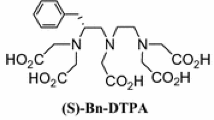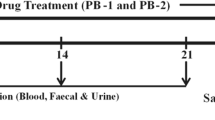Abstract
The increasing threats of nuclear terrorism have made the development of medical countermeasures a priority for international security. Injectable formulations of diethylenetriaminepentaacetic acid (DTPA) have been approved by the FDA; however, an oral formulation is more amenable in a mass casualty situation. Here, the diethyl ester of DTPA, named C2E2, is investigated for potential as an oral treatment for internal radionuclide contamination. C2E2 was synthesized and characterized using NMR, MS, and elemental analysis. The physiochemical properties of solubility, lipophilicity, and stability were investigated in order to predict its oral bioavailability. Finally, an animal efficacy study was conducted in Sprague Dawley rats pre-contaminated by intramuscular injection with 241Am(NO3)3 to establish effectiveness of the therapy via the oral route. Synthesis of C2E2 yielded a crystalline powder with high solubility and improved lipophilicity over DTPA. The ester was stable in both simulated gastric and intestinal fluids over the anticipated time course of absorption. Capsules containing C2E2 were demonstrated to be stable for 12 months under accelerated stability conditions. After a single dose, C2E2 enhanced the elimination of 241Am in a dose-dependent manner. Significant improvement was seen in both total 241Am decorporation and reduction of 241Am liver and skeletal burden. C2E2 was concluded to be effective when orally administered to 241Am-contaminated rats. It may therefore have potential for medical countermeasure in treating humans contaminated with 241Am or other transuranic elements. An oral capsule or powder for reconstitution may be suitable formulations for future development based on the physiochemical properties and anticipated dose required for efficacy.






Similar content being viewed by others
References
Food and Drug Administration. FDA approves drugs to treat internal contamination from radioactive elements. Rockville, MD. 2004 [Cited 2014 July 1] Available from: http://www.fda.gov/NewsEvents/Newsroom/PressAnnouncements/2004/ucm108339.htm.
International Commission on Radiological Protection. Committee 2. The metabolism of plutonium and related elements: a report of a Task Group of Committee 2 of the International Commission on Radiological Protection. 1st ed. Oxford: The Commission by Pergamon Press; 1986.
Dominguez-Gadea L, Cerezo L. Decontamination of radioisotopes. Reports of practical oncology and radiotherapy. Journal of Greatpoland Cancer Center in Poznan and Polish Society of Radiation Oncology. 2011;16(4):147–52.
Lloyd RD, Taylor GN, Mays CW, Jones CW, Bruenger FW, Atherton DR. Dependency of chelation efficacy upon time after 1st DTPA injection. Radiat Res. 1979;78(3):448–54.
Durbin PW. Actinides in animals and man. The chemistry of the actinide and transactinide elements. Netherlands: Springer; 2011. p. 3339–440.
Thompson RC. 1976 Hanford Americium Exposure Incident—overview and perspective. Health Phys. 1983;45(4):837–45.
Breitenstein BD. 1976 Hanford Americium Exposure Incident—medical-management and chelation-therapy. Health Phys. 1983;45(4):855–66.
Volf V. Effect of drinking Zn-DTPA on Pu-238 and Am-241 in rat bones. Radiat Environ Biophys. 1984;23(2):141–3.
Beaumont K, Webster R, Gardner I, Dack K. Design of ester prodrugs to enhance oral absorption of poorly permeable compounds: challenges to the discovery scientist. Curr Drug Metab. 2003;4(6):461–85.
Lipinski CA, Lombardo F, Dominy BW, Feeney PJ. Experimental and computational approaches to estimate solubility and permeability in drug discovery and development settings. Adv Drug Deliv Rev. 1997;23(1–3):3–25.
Lachenmeier DW, Haupt S, Schulz K. Defining maximum levels of higher alcohols in alcoholic beverages and surrogate alcohol products. Regul Toxicol Pharmacol. 2008;50(3):313–21.
Sueda K, Sadgrove MP, Huckle JE, Leed MGD, Weber WM, Doyle-Eisele M, et al. Orally administered DTPA penta-ethyl ester for the decorporation of inhaled 241Am. J Pharm Sci. 2014;103(5):1563–71.
Guilmette RA, Paeks JE, Lindenbaum A. Synthesis and therapeutic testing of mono- and dialkyl esters of pentetic (diethylenetriaminepentaacetic) acid for decorporation of polymeric plutonium. J Pharm Sci. 1979;68(2):194–6.
Raut SS, Barve KA, Bayes GS, Patil VR. Synthesis of water-soluble polyesters containing carboxy-functional groups in the polymers chain and study of their metal complexes. J Inorg Organomet Polym. 2010;20(2):343–55.
Volf V, Roth Z. Retention of 85sr in rats. I. Effect of sodium magnesium calcium strontium and barium sulphates. Acta Radiol Ther Phys Biol. 1965;3(3):216–28.
Huckle JE, Sadgrove M, Mumper RJ, Jay M. Species-dependent chelation of 241Am by DTPA di-ethyl ester. Health Phys. 2015;108(4):443–50.
Food and Drug Administration. Guidance for industry: dissolution testing of immediate release solid oral dosage forms. Rockville: Center for Drug Evaluation and Research; 1997.
Seidel A. Comparison of effectiveness of CaDTPA and ZnDTPA in removing Am-241 from rat. Radiat Res. 1973;54(2):304–15.
Durbin PW, Schmidt CT. Predicting the kinetics of chelating-agents in man from animal data. Health Phys. 1989;57:165–74.
Markley JF. Removal of polymeric plutonium from mice by combined therapy with the calcium chelate and penta-ethyl ester of DTPA. Int J Radiat Biol Relat Stud Phys Chem Med. 1963;7(4):405–7.
Sueda K, Sadgrove MP, Fitzsimmons JM, Jay M. Physicochemical characterization of a prodrug of a radionuclide decorporation agent for oral delivery. J Pharm Sci. 2012;101(8):2844–53.
Diethylenetriaminepentaacetic acid (DTPA) material safety data sheet. [Cited 2014 Aug 18] Available from: http://www.sigmaaldrich.com.
Fasinu P, Pillay V, Ndesendo VMK, du Toit LC, Choonara YE. Diverse approaches for the enhancement of oral drug bioavailability. Biopharm Drug Dispos. 2011;32(4):185–209.
Shankar GN, Potharaju S, Green CE. Evaluating the toxicity of novel Zn-DTPA tablet formulation in dogs and rats. Drug Dev Res. 2014;75:37–46.
Miller SC, Bruenger FW, Kuswik-Rabiega G, Liu G, Lloyd RD. Duration and dose-related effects of an orally administered, partially lipophilic polyaminocarboxylic acid on the decorporation of plutonium and americium. J Pharmacol Exp Ther. 1993;267(1):548–54.
Sueda K, Sadgrove MP, Jay M, Di Pasqua AJ. Species-dependent effective concentration of DTPA in plasma for chelation of Am-241. Health Phys. 2013;105(2):208–14.
Marcus CS. Administration of decorporation drugs to treat internal radionuclide contamination. RSO Mag. 2004;9(5):9–15.
Acknowledgments
This work was funded by the National Institute of Allergy and Infectious Diseases, National Institutes of Health, and U.S. Department of Health and Human Services under contracts HHSN266200500045C and HHSN272201000030C.
Author information
Authors and Affiliations
Corresponding author
Ethics declarations
Declaration of Interest
Drs. Jay and Mumper are co-founders of Capture Pharmaceuticals, which owns intellectual property related to C2E2. In addition to Drs. Jay and Mumper, Drs. Huckle and Sadgrove are named on a patent licensed to Capture Pharmaceuticals. However, no financial support from Capture Pharmaceuticals was provided in these studies.
Rights and permissions
About this article
Cite this article
Huckle, J.E., Sadgrove, M.P., Leed, M.G.D. et al. Synthesis and Physicochemical Characterization of a Diethyl Ester Prodrug of DTPA and Its Investigation as an Oral Decorporation Agent in Rats. AAPS J 18, 972–980 (2016). https://doi.org/10.1208/s12248-016-9916-z
Received:
Accepted:
Published:
Issue Date:
DOI: https://doi.org/10.1208/s12248-016-9916-z




